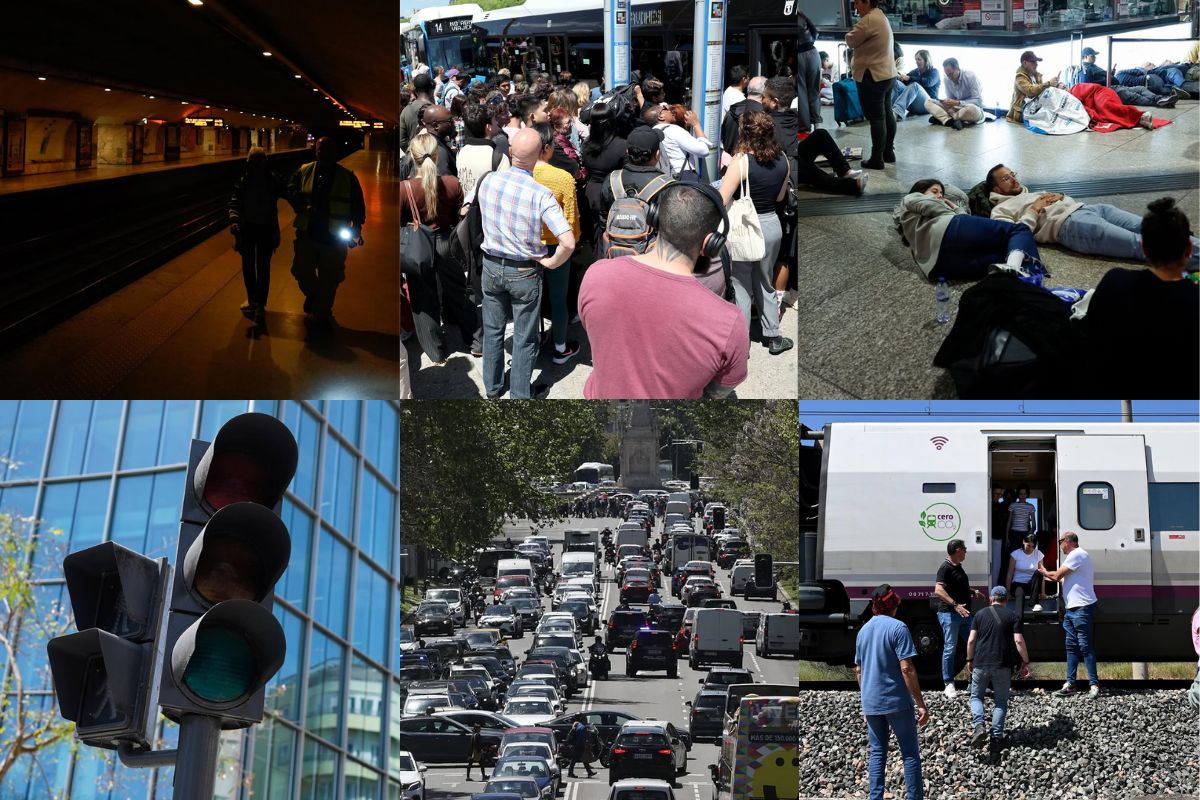Portugal-Spain Power Outage: Millions Affected as State of Emergency Declared

On Monday afternoon, an unprecedented Portugal-Spain power outage swept across Spain and Portugal, plunging vast parts of the Iberian Peninsula into darkness. What began as a sudden blackout around 12:30 PM local time quickly escalated into a national emergency, halting public transportation, grounding flights, shutting down hospitals, and leaving millions scrambling for basic necessities. In response, Spain formally declared a state of emergency, citing the need for coordinated federal assistance in the hardest-hit regions.
As questions swirl about the cause—and as recovery efforts unfold—this blackout is being called one of the worst in modern European history. From terrifying moments in underground metros to candlelit family meals and eerie cityscapes, the Spain power outage has captured global attention.
Table of Contents
ToggleWhat Happened: A Timeline of the Portugal-Spain Power Outage
The Portugal-Spain power outage crisis began without warning on April 28, 2025, when electrical grids across Spain and Portugal experienced a near-total shutdown. The blackout hit major cities such as Madrid, Lisbon, Barcelona, and Seville, affecting homes, businesses, transportation networks, and even emergency services.
Within minutes of the Portugal-Spain power outage:
- Trains ground to a halt, leaving over 35,000 people stranded on the railways or inside tunnels.
- Airports delayed or cancelled hundreds of flights, disrupting travel across Europe.
- Traffic lights stopped functioning, causing jams and minor accidents in several cities.
- Mobile and Wi-Fi networks went dark, cutting off communication for millions.
- The water supply was disrupted in various parts due to pump station failures.
Across Spain, rescue operations were launched almost immediately. Emergency services focused on evacuating people trapped in metros, elevators, and hospitals, while utility workers worked tirelessly to determine the source of the failure and begin restoration.
Government Response: Spain Declares National Emergency
By late afternoon, Spanish Prime Minister Pedro Sánchez announced that the country was entering a state of emergency in key regions including Madrid, Andalusia, and Extremadura. These areas had requested federal intervention as local authorities became overwhelmed by the Portugal-Spain power outage.
In Portugal, Prime Minister Luis Montenegro addressed the nation through a televised statement, urging calm and assuring citizens that every effort was being made to restore normalcy. He also dismissed speculation about a cyberattack, instead pointing to technical failures in the electrical grid as the root cause.
“Our priority right now is restoring essential services,” Montenegro said. “Hospitals, security forces, and emergency infrastructure are our main focus.”
The Cause: What Is “Induced Atmospheric Vibration”?
At the heart of the Portugal-Spain power outage crisis lies a rare and poorly understood atmospheric phenomenon. According to Portuguese grid operator REN, the blackout was likely caused by “induced atmospheric vibration”, a result of sudden and extreme temperature variations in Spain’s interior.
This atmospheric disturbance led to abnormal oscillations in the 400kV high-voltage lines—power lines that form the backbone of the interconnected European grid. These oscillations caused synchronisation failures between different national grids, particularly between Spain and France, triggering a chain reaction of collapses.
Red Eléctrica Española (REE), Spain’s national grid operator, emphasised the unusual scale of the failure. “The degree of imbalance exceeded what European systems are engineered to withstand,” said Eduardo Prieto, REE’s head of system operations. “When the French-Spanish link was lost, our system collapsed under the sudden imbalance of supply and demand.”
How Bad Was the Portugal-Spain Power Outage? The Human Impact
The human toll of the Portugal-Spain power outage extended beyond mere inconvenience.
- Hospitals had to shift to generator power, delaying surgeries and medical procedures.
- Elderly individuals and people with disabilities were left vulnerable, especially in high-rise buildings where elevators and electric medical equipment ceased functioning.
- Thousands of commuters spent hours trapped in subway cars or waiting in terminals, unsure of when they could resume their journeys.
- Supermarkets and shops closed, while panic buying erupted in others that remained open.
- Cash machines and card payment systems went offline, forcing people to rely on cash.
Social media, though spotty, served as a lifeline. People shared updates using satellite phones or sporadic mobile signals. Videos of stranded passengers in pitch-black metro tunnels and footage of darkened cities quickly went viral.
One such video came from Evan Beckerman, an American entrepreneur stuck at a train station in Madrid. “Total power outage across Spain and Portugal… Now we wait,” he wrote, capturing the uncertainty felt across the peninsula.
Power Restoration: How Much Has Been Recovered?
By late Monday night:
- 92% of Spain’s power had been restored, according to REE.
- Portugal reported power returning to 85 of 89 substations, per REN.
Electricity began returning in stages. In Barcelona and the Basque Country, lights flickered back on by early evening. Madrid’s streetlights and metro services gradually resumed by midnight. Lisbon’s power returned by dawn, though intermittent issues remained in the suburbs and surrounding regions.
Spanish natural gas supplier Enagás confirmed it activated emergency reserves to stabilise demand, while grid operators warned that total restoration could take up to a week due to the complexity of rebalancing transnational electricity flows.
Speculations and Misconceptions: Was It a Cyberattack?
Given the scale of the Portugal-Spain power outage, rumours of a cyberattack quickly spread. However, both Spanish and Portuguese authorities were swift to debunk this theory. “There is no indication that this was a cyber event,” said Prime Minister Montenegro. “It appears to be a technical and environmental failure.”
Experts also reiterated that the interconnected nature of Europe’s power grid can be both a strength and a vulnerability. While it allows for efficient energy sharing, it also means that a single failure can cascade across borders, as seen in this incident.
Looking Ahead: What This Means for Europe
The Portugal-Spain power outage event has sparked urgent calls across the EU for:
- Modernising power grids
- Developing climate-resilient infrastructure
- Improved emergency preparedness protocols
- Enhanced cross-border coordination
As climate change continues to drive extreme weather events, experts warn that similar power grid failures could become more common. Whether caused by natural forces or human error, Europe’s power infrastructure must now evolve to meet a changing world.
A Wake-Up Call for Energy Security
The Spain power outage of April 2025 was not just a blackout—it was a loud wake-up call. It exposed vulnerabilities in Europe’s electrical infrastructure, tested emergency response systems, and reminded millions how dependent modern life is on the uninterrupted flow of electricity.
While the lights are slowly turning back on, the memory of that sudden, continent-wide stillness will likely linger for years.
Published by Steve Philips
I am committed to crafting high-quality, unique articles that resonate deeply with readers, offering genuine value and insights. I aim to create content our audience will love and truly benefit from. View more posts
Recent Post
The Ultimate Guide to Crypto Wallet Screening and Matters

The Role of Smart Tech in Building London’s Future






